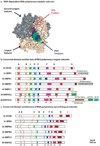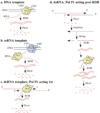Roles of RNA polymerase IV in gene silencing
- PMID: 18514566
- PMCID: PMC2679257
- DOI: 10.1016/j.tplants.2008.04.008
Roles of RNA polymerase IV in gene silencing
Abstract
Eukaryotes typically have three multi-subunit enzymes that decode the nuclear genome into RNA: DNA-dependent RNA polymerases I, II and III (Pol I, II and III). Remarkably, higher plants have five multi-subunit nuclear RNA polymerases: the ubiquitous Pol I, II and III, which are essential for viability; plus two non-essential polymerases, Pol IVa and Pol IVb, which specialize in small RNA-mediated gene silencing pathways. There are numerous examples of phenomena that require Pol IVa and/or Pol IVb, including RNA-directed DNA methylation of endogenous repetitive elements, silencing of transgenes, regulation of flowering-time genes, inducible regulation of adjacent gene pairs, and spreading of mobile silencing signals. Although biochemical details concerning Pol IV enzymatic activities are lacking, genetic evidence suggests several alternative models for how Pol IV might function.
Figures



References
-
- Werner F. Structure and function of archaeal RNA polymerases. Mol Microbiol. 2007;65:1395–1404. - PubMed
-
- Kettenberger H, et al. Complete RNA polymerase II elongation complex structure and its interactions with NTP and TFIIS. Mol Cell. 2004;16:955–965. - PubMed
-
- The-Arabidopsis-Genome-Initiative. Analysis of the genome sequence of the flowering plant Arabidopsis thaliana. Nature. 2000;408:796–815. - PubMed
-
- Onodera Y, et al. Plant nuclear RNA polymerase IV mediates siRNA and DNA methylation-dependent heterochromatin formation. Cell. 2005;120:613–622. - PubMed
-
- Herr AJ, et al. RNA polymerase IV directs silencing of endogenous DNA. Science. 2005;308:118–120. - PubMed
Publication types
MeSH terms
Substances
Grants and funding
LinkOut - more resources
Full Text Sources
Other Literature Sources

